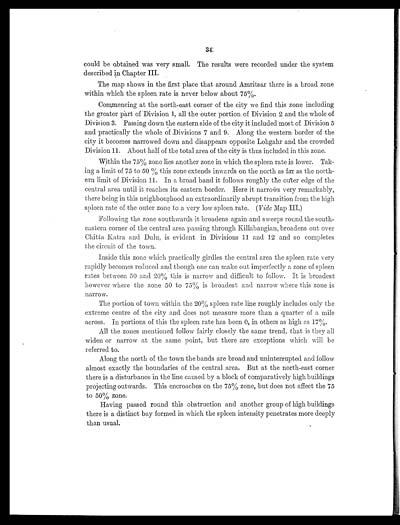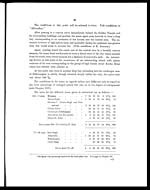Medicine - Institutions > Army health reports and medical documents > Scientific memoirs by officers of the Medical and Sanitary Departments of the Government of India > Number 46 - Malaria in the Punjab > Part II - Autumnal epidemic (fulminant) malaria
(46) Page 34
Download files
Individual page:
Thumbnail gallery: Grid view | List view

34
could be obtained was very small. The results were recorded under the system
described in Chapter III.
The map shows in the first place that around Amritsar there is a broad zone
within which the spleen rate is never below about 75%.
Commencing at the north-east corner of the city we find this zone including
the greater part of Division 1, all the outer portion of Division 2 and the whole of
Division 3. Passing down the eastern side of the city it included most of Division 5
and practically the whole of Divisions 7 and 9. Along the western border of the
city it becomes narrowed down and disappears opposite Lohgahr and the crowded
Division 11. About half of the total area of the city is thus included in this zone.
Within the 75% zone lies another zone in which the spleen rate is lower. Tak-
ing a limit of 75 to 50% this zone extends inwards on the north as far as the north-
ern limit of Division 11. In a broad band it follows roughly the outer edge of the
central area until it reaches its eastern border. Here it narrows very remarkably,
there being in this neighbourhood an extraordinarily abrupt transition from the high
spleen rate of the outer zone to a very low spleen rate. (Vide Map III.)
Following the zone southwards it broadens again and sweeps round the south-
eastern corner of the central area passing through Killabangian, broadens out over
Chitta Katra and Dulu, is evident in Divisions 11 and 12 and so completes
the circuit of the town.
Inside this zone which practically girdles the central area the spleen rate very
rapidly becomes reduced and though one can make out imperfectly a zone of spleen
rates between 50 and 20% this is narrow and difficult to follow. It is broadest
however where the zone 50 to 75% is broadest and narrow where this zone is
narrow.
The portion of town within the 20% spleen rate line roughly includes only the
extreme centre of the city and does not measure more than a quarter of a mile
across. In portions of this the spleen rate has been 0, in others as high as 17%.
All the zones mentioned follow fairly closely the same trend, that is they all
widen or narrow at the same point, but there are exceptions which will be
referred to.
Along the north of the town the bands are broad and uninterrupted and follow
almost exactly the boundaries of the central area. But at the north-east corner
there is a disturbance in the line caused by a block of comparatively high buildings
projecting outwards. This encroaches on the 75% zone, but does not affect the 75
to 50% zone.
Having passed round this obstruction and another group of high buildings
there is a distinct bay formed in which the spleen intensity penetrates more deeply
than usual.
Set display mode to: Large image | Zoom image | Transcription
Images and transcriptions on this page, including medium image downloads, may be used under the Creative Commons Attribution 4.0 International Licence unless otherwise stated. ![]()
| Permanent URL | https://digital.nls.uk/75058708 |
|---|
| Shelfmark | IP/QB.10 |
|---|---|
| Additional NLS resources: | |




